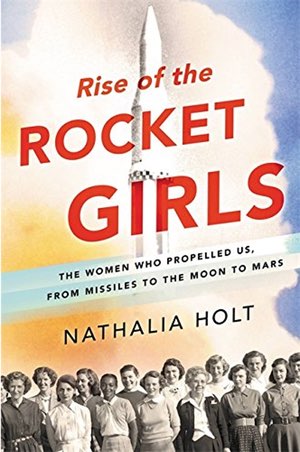Review: Rise of the Rocket Girlsby Jeff Foust
|
| Virtually the only technical jobs available for women were as “computers”, performing the calculations needed for the male engineering staff to design rocket engines, calculate trajectories, and other tasks in an era before electronic computers. |
NASA, perhaps, can be better, but it has improved dramatically in the professional opportunities available for women over its history. That’s most visibly played out in the astronaut corps, with women going from being excluded from consideration during the agency’s race to the Moon to comprising half of the most recent class of astronauts. Women have also found increasing opportunity in science, engineering, and management.
In Rise of the Rocket Girls, author Nathalia Holt tells one part of that story, through the women who worked at the Jet Propulsion Laboratory in its early years. In much of that early history, virtually the only technical jobs available for women were as “computers”, performing the calculations needed for the male engineering staff to design rocket engines, calculate trajectories, and other tasks in an era before electronic computers.
Such women were involved with the lab from its inception, when Caltech advised its founders that the campus was not the place to be testing rocket engines. Among those setting up in an isolated canyon north of town called Arroyo Seco was Barbara Canright, who, along with her husband, were hired as mathematicians to perform calculations to support the work of the founding engineers.
As JPL’s work grew during the Second World War to support the Army, so did the staff of female computers. They formed their own, close-knit group, separate from both the male engineers but also the women who had clerical and other non-technical jobs at the lab. It was also all women, by design: the woman who ran the group in the lab’s early years rejected any man who applied for computer jobs, seeing them as a “potential disruption” to a largely harmonious group of young women.
The women computers were critically involved in many of JPL’s early projects in missiles and, later, satellites, including the first U.S. satellite, Explorer 1. As JPL became a part of NASA, their worked changed to support some of the lab’s early spaceflight projects, including the Ranger series of lunar missions and the Mariner missions to Venus and Mars.
| Holt does a fine job balancing the personal stories of these women with the technical discussions of their work. |
A bigger change, though, was technological. Advancements in electronic computers threatened to make obsolete the jobs of the human computers, who relied on slide rules, logarithmic tables, and simple calculators. (JPL had IBM computers since the 1950s, but those early machines were often unreliable compared to their human counterparts.) Many transferred their skills in doing calculations to writing code, transitioning from computers to computer programmers. Later, as societal changes opened up career opportunities for women, they became engineers and managers at the lab.
Holt does a fine job balancing the personal stories of these women with the technical discussions of their work. The book spans several decades, from the lab’s beginnings almost to the present day, although with a particular focus on the 1940s through the ’60s. While Holt focuses on several key people, particularly those who worked at JPL for many years, the book includes a much larger group of people who worked as computers at the lab: so many that, at times, keeping track of everyone can be confusing. Digressions, particularly later in the book, into general spaceflight and even semiconductor and computer history can seem at times needlessly diverting from the human story at the core of the book.
Overall, though, Rise of the Rocket Girls tells a fascinating story of the women who made largely unseen yet essential contributions to the early history of spaceflight. Today, women have far more opportunities in science and engineering, including, and perhaps especially, at JPL: Holt notes at the end of the book that there are more women working at JPL now than at any other NASA center. While that workforce still doesn’t mirror society in general, leading to Bolden’s comments about how NASA can do better, this book shows how, in at least one aspect, how far it’s come.
